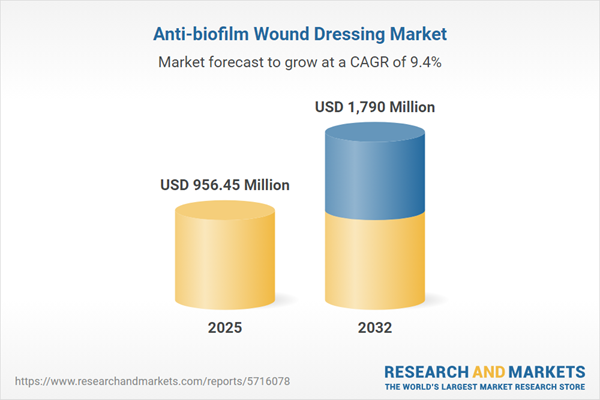Speak directly to the analyst to clarify any post sales queries you may have.
The anti-biofilm wound dressing market is advancing quickly, meeting demands from senior healthcare executives for reliable infection management and seamless integration into changing clinical operations. This sector is distinguished by its focus on elevating patient outcomes and supporting evolving care delivery frameworks.
Market Snapshot: Anti-Biofilm Wound Dressing Market Overview
The anti-biofilm wound dressing market is demonstrating robust expansion, with the global valuation estimated to grow from USD 872.24 million in 2024 to USD 956.45 million in 2025, and projected to reach USD 1.79 billion by 2032. This trajectory, marked by a compound annual growth rate of 9.44%, is driven by the increasing prevalence of chronic and acute wounds and a sustained emphasis on adopting innovative wound care solutions. Market growth stems from a heightened need to disrupt microbial biofilms, accelerate tissue healing, and deliver measurable improvements in patient care. Companies are actively advancing antimicrobial integration and optimizing dressing performance to enhance infection control and operational efficiency. Such innovation ensures that therapeutic solutions are well equipped to support modern healthcare settings.
Scope & Segmentation of the Anti-Biofilm Wound Dressing Market
This report provides senior leaders with detailed insights critical for procurement, clinical strategy, and operational performance, with segmentation designed to reveal actionable growth opportunities and guide informed strategy.
- Product Types: Alginate, film, foam (including honey, PHMB, and silver formulations), hydrocolloid, and hydrogel dressings with antimicrobial agents provide tailored solutions for a broad spectrum of wounds by balancing infection prevention with moisture regulation.
- End Users: Hospitals, ambulatory surgical centers, clinics, and home care providers benefit from these dressings, reflecting the increasing shift toward both outpatient and decentralized care models.
- Technologies: Natural and synthetic antimicrobials—including honey, silver, PHMB, iodine, zinc, and polymers—are deployed to deliver targeted infection control, facilitating reliable biofilm management consistent with modern care protocols.
- Applications: These dressings are essential for burns, diabetic foot ulcers, pressure injuries, and chronic wounds, ensuring reliable infection control and support at all stages of treatment.
- Sales Channels: Distribution through hospital and retail pharmacies, medical distributors, and online retailers ensures broad market access for institutional and home care settings.
- Regions: The Americas, Europe, Middle East, Africa, and Asia-Pacific are each assessed, with attention to how regional procurement strategies and regulatory standards influence product adoption and formulation specifications.
Key Takeaways: Strategic Insights for the Anti-Biofilm Wound Dressing Market
- Emerging dressings are combining antimicrobial activity with digital monitoring features for improved infection control and greater workflow efficiency.
- Adoption of anti-biofilm wound care solutions is accelerating in outpatient and home-based settings, reflecting the transition to patient-centric care pathways beyond hospitals.
- Innovations in material science—including sustained-release antimicrobials and integrated sensor technology—are enabling more personalized, preventive wound management strategies.
- Partnerships between manufacturers, care providers, and research organizations are helping to streamline product approvals and bring next-generation technologies to the market faster.
- Integrated offerings are increasing provider engagement, enhancing both biofilm disruption and access to actionable wound analytics, which strengthens collaborative supply frameworks.
- There is a rising focus on sustainability and eco-efficient manufacturing processes as healthcare organizations seek to meet evolving environmental standards in medical product development.
Tariff Impact in the United States
Shifting U.S. trade policies are contributing to increased operational costs for anti-biofilm wound dressing manufacturers and distributors. To address these pressures, industry participants are prioritizing closer supplier relationships, vertical integration, and modular production approaches. These strategies are designed to maintain stable supply chains and sustain innovation amid ongoing changes in global trade dynamics.
Methodology & Data Sources
The analysis uses a mixed-method approach, synthesizing expert interviews with regulatory and scientific literature reviews. Underpinned by PESTLE analysis and Porter’s Five Forces, this methodology enables a comprehensive and objective assessment of competitive dynamics and developing trends within the sector.
Why This Report Matters
- Senior decision-makers gain clear visibility into technological advancements, procurement trends, and regulatory factors impacting anti-biofilm wound dressing market direction.
- Detailed segmentation and channel analysis support targeted growth identification and enhance market strategy effectiveness across key regions and user groups.
- The insights presented inform investment priorities, guide refinement of product development pipelines, and strengthen supply chain decisions in a rapidly evolving wound care landscape.
Conclusion
Sustained progress in the anti-biofilm wound dressing market hinges on ongoing innovation, agile supply management, and proactive compliance with evolving clinical requirements. This report equips decision-makers with practical direction for success in developing advanced wound care solutions.
Additional Product Information:
- Purchase of this report includes 1 year online access with quarterly updates.
- This report can be updated on request. Please contact our Customer Experience team using the Ask a Question widget on our website.
Table of Contents
3. Executive Summary
4. Market Overview
7. Cumulative Impact of Artificial Intelligence 2025
List of Figures
Samples

LOADING...
Companies Mentioned
The key companies profiled in this Anti-biofilm Wound Dressing market report include:- Smith & Nephew plc
- Mölnlycke Health Care AB
- ConvaTec Group PLC
- 3M Company
- Coloplast A/S
- B. Braun Melsungen AG
- Paul Hartmann AG
- Medline Industries, LP
- Cardinal Health, Inc.
- Integra LifeSciences Holdings Corporation
Table Information
| Report Attribute | Details |
|---|---|
| No. of Pages | 194 |
| Published | October 2025 |
| Forecast Period | 2025 - 2032 |
| Estimated Market Value ( USD | $ 956.45 Million |
| Forecasted Market Value ( USD | $ 1790 Million |
| Compound Annual Growth Rate | 9.4% |
| Regions Covered | Global |
| No. of Companies Mentioned | 11 |









